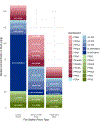Per- and polyfluoroalkyl substances (PFAS) and total fluorine in fire station dust
- PMID: 33542478
- PMCID: PMC8339150
- DOI: 10.1038/s41370-021-00288-7
Per- and polyfluoroalkyl substances (PFAS) and total fluorine in fire station dust
Abstract
Per- and polyfluoroalkyl substances (PFAS) are a class of over 4700 fluorinated compounds used in industry and consumer products. Studies have highlighted the use of aqueous film-forming foams (AFFFs) as an exposure source for firefighters, but little is known about PFAS occurrence inside fire stations, where firefighters spend most of their shifts. In this study, we aimed to characterize PFAS concentrations and sources inside fire stations. We measured 24 PFAS (using LC-MS/MS) and total fluorine (using particle-induced gamma ray emission) in dust from multiple rooms of 15 Massachusetts stations, many of which (60%) no longer use PFAS-containing AFFF at all and the rest of which only use it very rarely. Compared to station living rooms, turnout gear locker rooms had higher dust levels of total fluorine (p < 0.0001) and three PFAS: perfluorohexanoate (PFHxA), perfluoroheptanoate (PFHpA), and perfluorodecanoate (PFDoDA) (p < 0.05). These PFAS were also found on six wipes of station turnout gear. By contrast, the dominant PFAS in living rooms was N-ethyl perfluorooctane sulfonamidoacetic acid (N-MeFOSAA), a precursor to perfluorooctane sulfonate (PFOS) that still persists despite phase-outs almost two decades ago. The Σ24 PFAS accounted for less than 2% of fluorine in dust (n = 39), suggesting the potential presence of unknown PFAS. Turnout gear may be an important PFAS source in stations due to intentional additives and/or contamination from firefighting activities.
Keywords: Analytical Methods; Emerging Contaminants; Endocrine Disruptors; Healthy Buildings; PFAS; Perfluorinated Chemicals; Vulnerable Occupations; Workplace Exposures.
© 2021. The Author(s), under exclusive licence to Springer Nature America, Inc. part of Springer Nature.
Conflict of interest statement
Conflict of Interest
The authors declare no conflict of interest.
Figures



References
-
- OECD. Toward a New Comprehensive Global Database of Per- and Polyfluoroalkyl Substances (PFASs). 2018.
-
- Wang Z, Cousins IT, Scheringer M, Hungerbuehler K. Hazard assessment of fluorinated alternatives to long-chain perfluoroalkyl acids (PFAAs) and their precursors: Status quo, ongoing challenges and possible solutions. Environ Int 2015; 75: 172–179. - PubMed
-
- Lau C, Anitole K, Hodes C, Lai D, Pfahles-Hutchens A, Seed J. Perfluoroalkyl acids: A review of monitoring and toxicological findings. Toxicol Sci 2007; 99: 366–394. - PubMed
Publication types
MeSH terms
Substances
Grants and funding
LinkOut - more resources
Full Text Sources
Other Literature Sources

